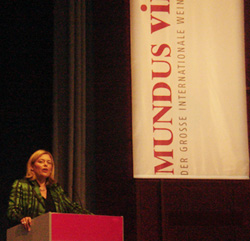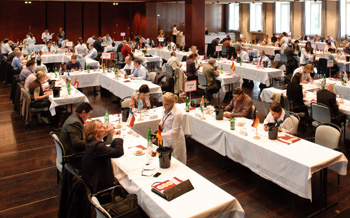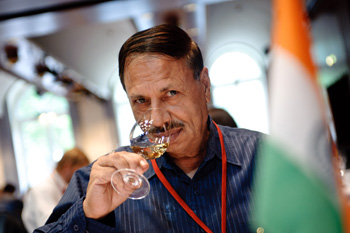Photos By:: Ralf Ziegler
 Started in 2001, the record participation of 5883 wines from 43 countries is even more significant since the EU rules allow any competition even if it is not officially recognised, to conduct such competitions since the reforms applicable since 2007. Earlier, a competition had to be recognised officially by some bodies authorized to do so. Started in 2001, the record participation of 5883 wines from 43 countries is even more significant since the EU rules allow any competition even if it is not officially recognised, to conduct such competitions since the reforms applicable since 2007. Earlier, a competition had to be recognised officially by some bodies authorized to do so.
The official recognition to MUNDUSvini came in 2003, said Julia Klöckner the Parliamentary Secretary in the federal government, who is a wine expert and has been a jurist with the competition earlier. The Awards labels were allowed to be pasted on the bottles only after this policy came into existence. She spoke at length about the importance of the competition for producers as she inaugurated the competition where Christoph Meininger, owner of the Meininger group of publications and the Competition with his sister Andrea, talked about the strictness with which it followed the OIV rules.
 There are three types of medals awarded – Great Gold, Gold and Silver. Interestingly, the 100 point marking scale sees a lowering of points for the Honours to 92, 85, and 82 this year from the earlier 96, 90 and 85 respectively. Many jurists find this a tad too liberal for the medals and feel that this is to help producers win more medals and may not be very good from the point of view of consumers’ who are really swayed by Awards. There are three types of medals awarded – Great Gold, Gold and Silver. Interestingly, the 100 point marking scale sees a lowering of points for the Honours to 92, 85, and 82 this year from the earlier 96, 90 and 85 respectively. Many jurists find this a tad too liberal for the medals and feel that this is to help producers win more medals and may not be very good from the point of view of consumers’ who are really swayed by Awards.
Ingrid Adamiker, who was judging as a representative of OIV (each competition under the aegis of OIV must have their representative present to ensure the procedures are strictly followed), clarified, ‘the current change is the result of an OIV panel assigned with the specific job of recommending changes had only suggested these points at the lower end of the scale and the organisers were free to choose more stringent norms.
But it is noteworthy that the maximum number of medals allowed is still restricted to 30% of the total. Therefore, the ‘liberal’ scoring would not add to the total number of medals awarded though there may be more Gold and Double Golds under the new system. It would be curious to take a peep into the results which are expected to be announced in mid September and would be available to our readers at www.meininger.de
 |
| Jhanda Ooncha Rahe Hamara- at Mundusvini |
The competition is being judged over two week-ends from Friday to Sunday by 45 panels of 285 wine experts including journalists, enologists, buyers from international department stores, retailers and importers from 49 countries. ‘Among the experts will be renowned tasters such as Ned Goodwin (journalist and Master of Wine, Japan), Christian Mürau (the TV presenter and producer of wine films, Germany), Ingrid Adamiker (OIV Commissioner, Austria), Wolfgang Heess (honorary President of the Federation of German Oenologists, Germany), Jean Smullen (journalist, Ireland), Hildegard Heymann (professor of Sensory Studies at the University of Davis, USA), Subhash Arora (President of the Indian Wine Academy and journalist, India), Jacques Orhon (author of wine books and chef sommelier, Canada)’ says a Press Release by the organisers. If the samples submitted are an indication of what the world is drinking, reds rule the roost with 52% of wines consumed being red, while the white wines hold 36% of the share. Rosé remains constant with 4% while 7% of the samples represent the sparkling segment including Champagne, Cava and Prosecco. Ports, Madeira, Sherry and other fortified wines form the balance of the 1% segment.
Jordan, Russia and Taiwan have made an entry for the first time. Interestingly, India and China (of BRIC fame) have yet to make an entry. It ought to be important to have India participate through the Indian Grape Processing Board (IGPB) which should subsidise it by 50%, a common practice in most of the Eastern European and several other smaller wine producing countries. Any medals won would not only directly benefit the producers but would also make the world wake up to the fact that India does produce wine.
The competition would also give a feedback to the producers about the wine quality in the eyes of the international experts who taste them blind without knowing the grape or the country of origin. At the end of each day, a list describing the grape varietal and the country is given to each taster. For instance, Brazil surprised the judges, with over 70% of the wines being corked and scoring rather poorly. The silver lining is that the producers might not have otherwise received a proper feedback. Once they are informed about the result, they could focus on improving upon the problem.
The competition has a lot of other plusses from the point of view of judges who not only learn about the wines they have tasted blind through the wine details (grape, country and appellation) provided at the end of each day but also test their own judging against the other jury members through a graph showing their marks in relation to the average of their fellow judges.
Unlike in the Vinitaly wine competition where it takes the whole day to taste 50 wines- maximum number allowed under the OIV rules, the judges are let off for lunch only when they get their daily dose of tasting almost 50 wines. This is followed after lunch by a trip to some wine region, winery and/or a sight seeing destination which as a tourist one may not be able to discover.
For example, the trip to a co-operative Waldulmer in Baden with 200 growers owning around 120 hAs, with 85% of production being Pinot Noir had 9 growers present over 50 wines, a reminder that the region has been improving the quality of reds slowly but surely. The next day’s trip to an Alsatian winery Arthur Metz was an eye opener-a lone exception to the rule that ‘you need big fortune to make a small fortune in wine making’ and an example of why you don’t need to give an arm and a leg to drink a Grand Cru from France- a white Grand Cru from Alsace can be enjoyed for as little as € 11.
The visit to Heidelberg and a boat ride in river Neckar reminded me of the old adage, ‘Ich hab’ mein hertz in Heidelberg vorloren’ ( I lost my heart to Heidelberg) when I used to live in Germany centuries ago. An interesting tasting in the boat of six wines from Galicia in Spain made from Albariño varietal was yet another nasty reminder of the high taxes in India and why we could not afford to import the delicious, to me the best white wine from Spain.
Every competition has its detractors but the general consensus at Neustadt has been that despite any profits MUNDUSvini might generate through the competition, it is performing a big service for the wine industry through this competition which has tasted over 36,000 wines during the last 10 years, awarding medals to over 11,000. As Susanne Denzer, Tasting Director of the competition says, ‘MUNDUSvini has become an internationally accepted and acknowledged brand in the wine competitions. That is why we keep on doing consistently better every year and have not been affected so badly by recession as most others.’
After ten years of positive growth every year in the first decade of its existence, the organisers are looking at a repeat performance during the next decade too.
Subhash Arora |